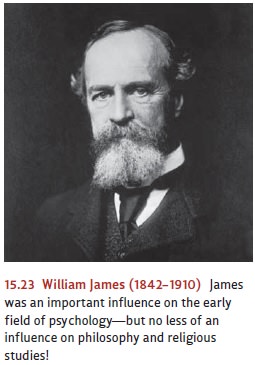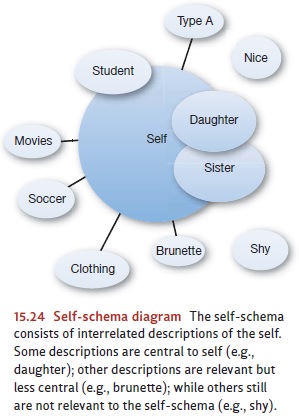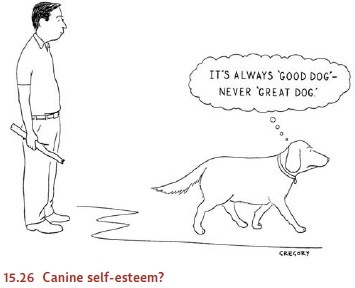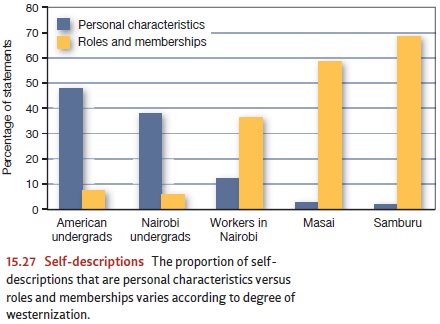Chapter: Psychology: Personality
The Humanistic Approach: The Self
The
Self
This
discussion of self-actualization raises an important question: What exactly is
the self that the humanists
talked about, and where
does it come
from? More than
a century ago—well before
the humanists such
as Maslow and
Rogers came onto
the scene— William James (1890;
Figure 15.23) distinguished two aspects of the self, which he called the “I”
and the “me.” The “I” is the self that thinks, acts, feels, and believes. The
“me,” by contrast, is the set of physical and psychological attributes and
features that define who

you
are as a person. These include the kind of music you like, what you look like,
and the activities that currently give your life meaning. Half a century after
James first made this distinction, the humanist Carl Rogers used similar
language to talk about how the self-concept develops in early
childhood and eventually comes
to include one’s
sense of oneself—the
“I”—as an agent
who takes actions and makes
decisions. It also includes one’s sense of oneself as a kind of object— the
“me”—that is seen and thought about, liked or disliked (C. R. Rogers, 1959,
1961). Indeed, the self-concept was
such an important
aspect of Rogers’
approach that he referred to his theory as self theory, an
approach that continues to inspire contempo-
rary researchers
who seek to explain the
motives that activate
and support human behavior (Deci & Ryan, 2000).
SELF - SCHEMA
For
each of us, our sense of self is a key aspect of our personality, and each of
us has a set of beliefs about who we are and who we should be, and a body of
knowledge about our val- ues and our past behaviors. This knowledge about
ourselves constitutes, for each person, a

self-schema(Markus, 1977; Figure 15.24). This
schema is not just a passive record of ourprior experiences; instead, the
schema actively shapes our behaviors, perceptions, and emo-tions. For example,
a person might have a schema of himself as a smart person who does well at
school. This self-schema will make certain situations, such as academic tests,
seem more important and consequential. The self-schema will also guide many of
his choices, such as opting to attend a more rigorous college rather than a
“party school” or spending the extra hour polishing a term paper rather than heading
off to get coffee with friends.
The
self-schema is not just a random list of characteristics. Instead, it is a
highly organized (although not always entirely consistent) narrative about who
one is. McAdams and colleagues (McAdams, 1993, 2001; McAdams & Pals, 2006)
refer to such personal narratives as personal
myths—in essence, “stories” that provide a sense of direction and meaning
for our lives. Moreover, given this important role for these nar-ratives, it
cannot be surprising that these narratives are resistant to change, and, in
fact, studies have shown that even people with negative self-concepts
tenaciously cling to these views, and seek out others who will verify these
views (Swann, Rentfrow, & Guinn, 2002).
Information
relevant to our self-schema is also given a high priority. For example, in
sev-eral studies, people have been shown a series of trait words and asked to
make simple judg-ments regarding these words (e.g., Is the word in capital
letters? Is it a positive word? Does it describe me?). When asked later to
remember the traits that they previously saw, partici-pants were more likely to
recall words presented in the “Does it describe me?” condition than in the
other conditions, suggesting that material encoded in relationship to the self
is better remembered (T. B. Rogers, Kuiper, & Kirker, 1977). These findings
are buttressed by neuroimaging studies that show the portions of the medial
prefrontal cortex are particu-larly active when people are engaged in
self-referential processes (as compared to when they are making judgments about
how the words are written, whether the words are good or bad, or even whether
they are characteristic of a friend; Heatherton et al., 2006).

Interestingly,
people seem to have schemas not only for who they are now, their actualselves, but also for who they may
be in the future—mental representations of
possible selves (Markus & Nurius, 1986; Figure 15.25). These include a
sense of theideal self that one would
ideally like to be (e.g., someone who saves others’ lives), and the ought self that one thinks one should be
(e.g., someone who never lies or deceives others) (E. T. Higgins, 1997).
According to E. Tory Higgins, when we compare our actual self to our ideal
self, we become motivated to narrow the distance between the two, and we
develop what he calls a promotion focus.
When we have this sort of focus, we actively pursue valued goals—a pursuit that
results in pleasure. In contrast, when we compare our actual self to our ought
self, we become motivated to avoid doing harm, and we develop what Higgins
calls a prevention focus. This kind
of focus is associated with feelings of relief.
Notice,
therefore, that schemas are not just dispassionate observations about
our-selves; instead, they often have powerful emotions attached to them and can
be a compelling source of motivation. This is why the schemas are typically
thought of as an aspect of “hot”
cognition (emotional and motivational) rather than “cold” cognition (dispassionate and analytical).
SELF -
ESTEEM AND SELF - ENHANCEMENT
The
“hot” nature of self-schemas is also evident in the fact that these schemas
play a pow-erful role in shaping a person’s self-esteem—a broad assessment that reflects the relative balance
of positive and negative judgments about oneself (Figure 15.26). Not
surprisingly, self-esteem is not always based on objective self-appraisals.
Indeed, people in Western

cultures
seem highly motivated to view themselves as different from and superior to
other people—even in the face of evidence to the contrary (Sedikides &
Gregg, 2008). This is manifest, for example, in the fact that most Americans
judge themselves to be above average on a broad range of characteristics (see
Harter, 1990). Thus, in 1976–1977 the College Board asked 1 million high-school
students to rate themselves against their peers on leadership ability. In
response, 70% said they were above average, and only 2% thought they were
below. Similar findings have been obtained in people’s judgments of talents
ranging from managerial skills to driving ability (see Dunning, Meyerowitz,
& Holzberg, 1989). And it is not just high-school students who show these
effects. One study of university pro-fessors found that 94% believed they were
better than their colleagues at their jobs (Gilovich, 1991).
What
is going on here? Part of the cause lies in the way we search our memories in
order to decide whether we have been good leaders or bad, good drivers or poor
ones. Evidence suggests that this memory search is often selective, showcasing
the occasions in the past on which we have behaved well and neglecting the
occasions on which we have done badly—leading, of course, to a self-flattering
summary of this biased set of events (Kunda, 1990; Kunda, Fong, Sanitioso,
& Reber, 1993).
In
addition, people seem to capitalize on the fact that the meanings of these
traits— effective leader, good at getting along with others—are often
ambiguous. This ambigu-ity allows each of us to interpret a trait, and thus to
interpret the evidence, in a fashion that puts us in the best possible light.
Take driving ability. Suppose Henry is a slow, careful driver. He will tend to
think that he’s better than average precisely because he’s slow and careful.
But suppose Jane, on the other hand, is a fast driver who prides her-self on
her ability to whiz through traffic and hang tight on hairpin turns. She will
also think that she’s better than average because of the way she’s defined driving
skill. As a result, both Henry and Jane (and, indeed, most drivers) end up
considering themselves above average. By redefining success or excellence, we
can each conclude that we are successful (Dunning & Cohen, 1992; Dunning et
al., 1989).
CULTURE
AND THE SELF
Although
the self-schema is important for all of us, the content of the schema varies from individual to individual and, it
seems, from one culture to the next. When they think about themselves,
Americans tend to think about their broad, stable traits, traits that apply in
all settings, such as athletic, disorganized, and creative. Things are
differ-ent for people living in interdependent, collectivist cultures. They
also view themselves as having certain traits, but only in specific situations,
and so their self-descriptions tend to emphasize the role of the situation,
such as quiet at parties, or gentle with their parents (Ellemers, Spears, &
Dossje, 2002; D. Hart, Lucca-Irizarry, & Damon, 1986; Heine, 2008).
Similarly, people in interdependent cultures tend to have self-concepts that
emphasize their social roles, and so, when asked to complete the statement “I
am . . . ,” Japanese students are more likely to say things like “a sister” or
“a student,” whereas American students are more likely to mention traits like
“smart” or “athletic” (Cousins, 1989). Similar differences can show up within a
single culture. Thus, as shown in Figure 15.27, Kenyans who were least
westernized overwhelmingly described themselves in terms of roles and memberships
and mentioned personal characteristics such as traits only 2% of the time. By
contrast, Kenyans who were most westernized used trait terms nearly 40% of the
time, and only slightly less than American under-graduates (Ma &
Schoeneman, 1997).

There
is also variation from one culture to the next in how people evaluate
them-selves. In individualistic cultures, people seek to distinguish themselves
through personal achievement and other forms of self-promotion, with the result
of increased self-esteem. In collectivistic cultures, on the other hand, any
form of self-promotion threatens the relational and situational bonds that glue
the society together. Indeed, to be a “good” person in these cultures, one should
seek to be quite ordinary—a strategy that results in social harmony and meeting
collective goals, not increased self-esteem (Kitayama, Markus, Matsumoto, &
Norasakkunkit, 1997; Pyszczynski, Greenberg, Solomon, Arndt, & Schimel,
2004). For them, self-aggrandizement brings disharmony, which is too great a
price to pay. Evidence for this conclusion comes from a study in which American
and Japanese college students were asked to rank their abilities in areas
ranging from math and memory to warmheartedness and athletic skill. The
American students showed the usual result: Across all the questions, 70% rated
them-selves above average on each trait. But among the Japanese students, only
50% rated themselves above average, indicating no self-serving bias, and perhaps
pointing instead to a self-harmonizing one (Markus and Kitayama, 1991; Takata,
1987; also Dhawan, Roseman, Naidu, & Rettek, 1995).
Related Topics